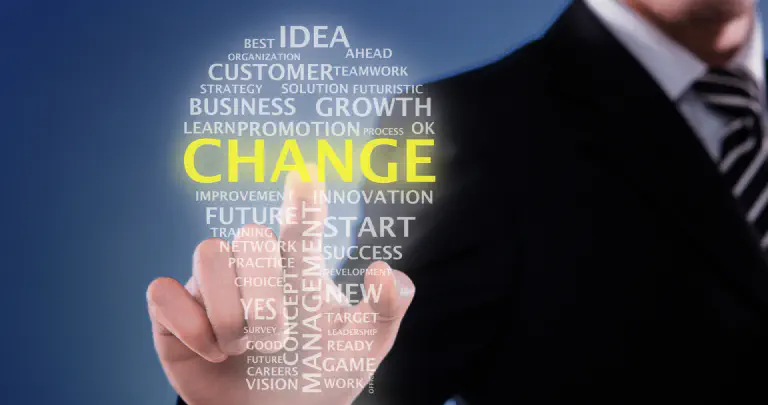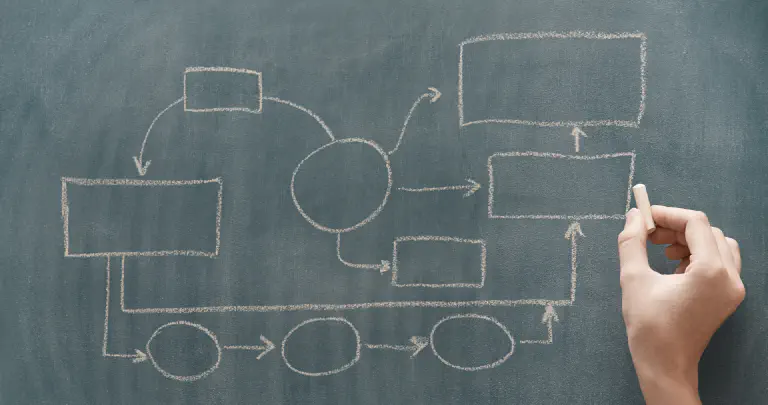Why is active change management important? #
Companies are exposed to dynamic environmental conditions and must constantly adapt processes and structures in order to maintain their competitiveness and ability to innovate. Whether you want to introduce new technologies such as AI and no-code solutions, develop new processes to implement legal requirements or prepare for expansion into new markets, the focus is always on people - your employees and customers. Active change management is important in order to take objections and concerns into account, involve all stakeholders and plan and implement measures in such a way that they are transparent and do not overwhelm anyone. In this way, you ensure that changes are lived. Otherwise, you run the risk of demotivating your employees and possibly even losing customers to competitors .
What does change management mean? #
Before we delve deeper into the topic, let’s clarify the term. After all, it is on (almost) everyone’s lips these days. However, as with many other inflationary buzzwords, there is often a lack of understanding of exactly what it means. A definition of change management is therefore advisable.

Change management refers to the implementation of all strategies, processes and measures that aim to bring about profound changes in departments or entire organizations in a targeted and systematic manner. This can involve organizational, technological or cultural changes - with the latter being the most challenging case. The decisive factor is that the change process is complex and far-reaching for the organization concerned. If only individual processes are optimized, this is not referred to as change management.
Are change management and transformation the same thing? #
In short: No, the two terms are closely related but not synonymous. The term “transformation” usually also describes large-scale, fundamental changes - such as the complete realignment of a business model or the digital transformation of a company. Change management, on the other hand, refers to planning and supporting this change in a structured manner and thus setting the course for sustainable success. To stay with the example of digitalization: The term “digital transformation” tends to specify the strategic goal, whereas the specific management and implementation falls under change management.

What role do employees play in change management? #
As already mentioned, a successful change management process stands and falls with the active involvement of your employees. After all, they are the ones who ultimately have to apply new processes, change their working methods and live the changes on a day-to-day basis. Emotions play an important role in change management. If fears, concerns and uncertainties are not taken seriously at an early stage, resistance and frustration will quickly arise, which you want to avoid at all costs. Transparency, regular communication and, if necessary, further training opportunities are the absolute basics for involving employees as partners and co-creators. Team meetings, workshops and one-to-one discussions help to reduce concerns and dissolve blockages.
The 7-phase model according to Streich #
In this context, responsible change managers should regularly remind themselves of Streich’s 7-phase model. Richard Streich and Sonja Sackmann developed this model to describe how people emotionally experience and react to far-reaching changes:
-
1. Phase: Shock
-
2. Phase: Denial
-
3. Phase: Insight
-
4. Phase: Acceptance
-
5. Phase: Trial and error
-
6. Phase: Insight
-
7. Phase: Integration
Accompanying employees through the first two phases and keeping them as short as possible is a central task of managers and change managers in change processes.

Which change management models are available? #
As in other areas, there are various models available to you in change management. These offer supposedly simple answers and promise a clear structure to make your change management planning concrete and controllable. However, none of these models does full justice to the complex dynamics of change management processes. Let’s take a critical look at the four models most frequently mentioned in change management guides:
-
Lewin’s 3-phase model
-
the 8-stage model according to Kotter
-
the 5-phase model according to Krüger
-
the ADKAR model
The 3-phase model according to Lewin #
This model by the German social psychologist Kurt Lewin is one of the oldest models in change management. It was first published in 1947 and originally dealt solely with cultural change processes. Lewin, who lived in exile in the USA, formulated three phases in change management:
-
Unfreeze: The existing status quo is thawed in order to create a willingness to change in the first place.
-
Change: The change processes are implemented.
-
Refreeze: The new processes are internalized and stabilized.
Disadvantages of the 3-phase model
At the heart of Lewin’s model is the need to consciously prepare, sustainably anchor and stabilize changes through well thought-out change management planning. What sounds logical at first turns out to be an outdated approach on closer inspection:
-
To freeze an organizational or procedural state is hardly conceivable in modern, agile companies.
-
Lewin’s mechanistic understanding of structures and organizations no longer corresponds to reality.
The 8-step model according to Kotter #
Another classic among change management methods is John Kotter’s 8-step model. Kotter’s model can best be understood as a change management concept, as he formulates a clear process instead of more abstract change management phases:
- Create urgency
- Build leadership team
- Develop vision
- Communicate vision
- Remove obstacles
- Achieve short-term success
- Drive change forward
- Anchoring change
Disadvantages of the 8-step model
Kotter’s model also makes it clear that transformation is only possible if the urgency is understood and there is a clear vision from the outset. Overall, Kotter takes a much more practice-oriented and granular approach to the topic than Lewin or Krüger. However, there is also criticism:
-
Change management measures do not usually run in a linear fashion, but often in parallel.
-
Kotter’s steps seven and eight, the actual implementation, are far more complex and time-consuming than his model suggests.
-
Kotter sees change management as being prescribed and implemented by management and neglects the active role of employees.
-
It remains open how to deal with setbacks.
5-phase model according to Krüger #
This model by economist Wilfried Krüger identifies five successive phases in change management:
- Initialization: identifying the need for change and formulating initial goals.
- Conception: Design solutions, define measures and project teams.
- Mobilization: Involve employees, create acceptance and promote motivation.
- Implementation: Implement planned measures operationally.
- Continuation: Ensure success, define and monitor new standards.
The third and fourth phases are particularly critical milestones in change management, as this is where potential resistance is reduced and a positive willingness to change is created.
Disadvantages of the 5-phase model
Although Krüger’s model names the important phases in change management, like Kotter it assumes a linear, rigid change management concept. How exactly the implementation should work remains rather vague. In addition, Krüger relies on offering employees special incentives to embrace change rather than involving them and convincing them that it makes sense.
ADKAR model #
The ADKAR model was developed by change manager Jeff Hiatt and is based on the analysis of change processes in around 700 organizations. It is considered to be particularly practice-oriented and focuses on the individual change processes of employees. ADKAR is an acronym for Awareness, Desire, Knowledge, Ability and Reinforcement. Similar to the 5-phase model, Hiatt’s approach also aims to create awareness of the need for change and to support sustainable implementation.
Disadvantages of the ADKAR model
Hiatt’s model focuses radically on the individual employee and therefore differs significantly from the three other phase models presented. However, this is also the reason for the central criticism:
-
The ADKAR model neglects the importance of group dynamics.
-
It neglects the technical and procedural aspects of change management processes.
-
It provides a rigid framework for a change management concept, but no implementation model.
Change management measures: What is the best way to proceed? #
Each of the models mentioned assumes a linear progression of various change management measures - in this respect they are very similar to the aforementioned 7-phase model according to Streich. As shown, however, this linear structure conveys a skewed picture. The models clearly show which individual steps are important and may therefore be helpful as a framework for change management strategies. However, you will search in vain for real recommendations for action and measures.

So how do you actually proceed?
-
Start with an analysis: What should be changed and what is the goal?
-
Identify the relevant stakeholders before starting individual measures.
-
Create trust through open communication.
-
Define roles and responsibilities clearly.
-
Together with the management, demonstrate willingness to change.
-
Measure progress continuously in order to be able to react to problems in good time.
Change management and project management #
If you see parallels with project management, it’s no coincidence. This is because change management and project management are closely interlinked. While in an IT project, for example, the project manager drives the technical introduction of new software, change management in IT is about getting employees on board and ensuring that the new software is accepted and used. This means that project management methods are usually also helpful methods in change management.
Stakeholder analysis #
With a stakeholder analysis, you get to know the stakeholders and their interest in your project.
How do you carry out a stakeholder analysis?
-
Identification: Who could be affected by your project? Also consider people outside your company.
-
Prioritization: Not all stakeholders are equally affected by changes. Prioritize your stakeholders according to interest and commitment - this will also make subsequent stakeholder management easier.
-
Stakeholder map: Now categorize your stakeholders according to various factors, e.g. customers, employees, external parties and management.
Culture Mapping #
The corporate culture is shaped, among other things, by the day-to-day behavior of employees towards each other as well as the values and norms that management lives by and sets. It sometimes has more, sometimes less influence on the success of change management measures. A culture map provides you with important information to identify any stumbling blocks in advance.
How does culture mapping work?
Start by mapping different subcultures within your company, e.g. individual departments or divisions. Then identify groups of five to six people who best represent these different cultures and talk to them. Use the resulting information on potential blockers and opportunities to create your culture map. It is best to work with a whiteboard tool or with diagrams, e.g. a scatter diagram or a tree map, and incorporate the information gained into your change management planning.
Process map #
You can use the process map to visualize various processes, often in the form of a flow chart. This also gives people who are not directly involved in the change management process a good overview and important information. Such diagrams are particularly helpful in your change management planning to show the current status.

Force field analysis #
With Kurt Lewin’s force field analysis, you examine which forces or factors speak for or against a change or a proposal. It is also called an obstacle and resource analysis and is similar to a SWOT analysis .
How does the force field analysis work?
-
Plan definition: What is your goal?
-
Determine tools: Which (internal and external) forces can help you?
-
Recognize obstacles: What forces (including potential ones) are working against change?
-
Weighting: Quantify the expected impact of each force with a score.
Risks in change management #
Change projects often fail due to lack of acceptance, unclear communication or a lack of resources. However, missing or unrealistic change management goals are also common causes. In the rarest of cases, however, these projects fail because of the employees, even if they are then accused of being unable or unwilling to embrace something new. As a rule, employees simply recognize very quickly whether changes are in your interests or not. You should therefore take your employees’ interests into account at an early stage. Create careful, transparent change management planning in order to be well prepared for possible risks and allow sufficient time for sustainable implementation - this step can take several months or even longer.
How are change management and digitalization connected? #
Good planning, analyses, regular and transparent communication, stakeholder management: without the right tool, you can hardly cover these tasks efficiently. And just as successful digitalization requires a well-thought-out change management concept, digitalization is in turn a prerequisite for successful change processes. New technologies such as cloud solutions, no-code platforms, AI and automation tools can make all the difference and determine the success or failure of your project. The most important criterion here is your specific requirements: Choose a tool that best suits your ideas and is scalable. Otherwise, you may end up switching from one software to another or working with different tools, which will only complicate your change management measures unnecessarily.
SeaTable as a change management tool #
SeaTable is a modern no-code database tool that you can flexibly adapt to the requirements of your company or project. Especially for change management measures, this solution offers a variety of functions with which you can easily cover other processes as well. Thanks to the intuitive user interface and the numerous customization options, new users will quickly find their way around without the need for training or lengthy implementations.
Transparent real-time collaboration, integrated chat and notification functions, shared data management and automation help you achieve your change management milestones. For example, use our free SWOT analysis template for your force field analysis or our project structure plan for your change management planning.
Scroll through our interactive SWOT analysis template as an example for your force field analysis.
Scroll through our interactive work breakdown structure template as an example for your change management planning.
Customizable dashboards and statistics allow you to review project progress at regular intervals. With the Universal App Builder, you can design a user-friendly front end for your stakeholders in just a few minutes, while the Whiteboard and Tree plugins allow you to maintain a complete overview of your change management.
As a cloud solution , SeaTable is hosted exclusively on servers in Germany and is fully GDPR compliant. For even greater control over your data, you can host the software on your own servers with SeaTable Server . The free basic version provides you with numerous basic functions.
Conclusion #
Active change management is a decisive success factor for companies when it comes to meeting the challenges of the present. Effective implementation is based on a clear concept, the involvement of employees, the right change management methods, an empathetic approach to emotions - and the use of the right tools.
FAQ - Change management planning #
What are the biggest success factors in change management processes?
Successful change management depends largely on three factors:
-
Clear definition of objectives
-
Involvement of managers
-
Clear communication and transparency
How can employees' willingness to change be increased in the change management process?
What are the biggest stumbling blocks in change management?
The biggest risks that you can counter through targeted change management methods include
-
Unclear target definition or lack of strategic involvement
-
Resistance due to lack of understanding or concerns about loss of control
-
Lack of resources
-
Overload due to too many simultaneous measures
You can avoid risks as early as the change management planning stage through early risk analysis, transparent communication and a clear definition of change management objectives.
TAGS: Operations
